Charles E W Bean, Diaries, AWM38 3DRL 606/251/1 - 1915 - 1936 - Part 19


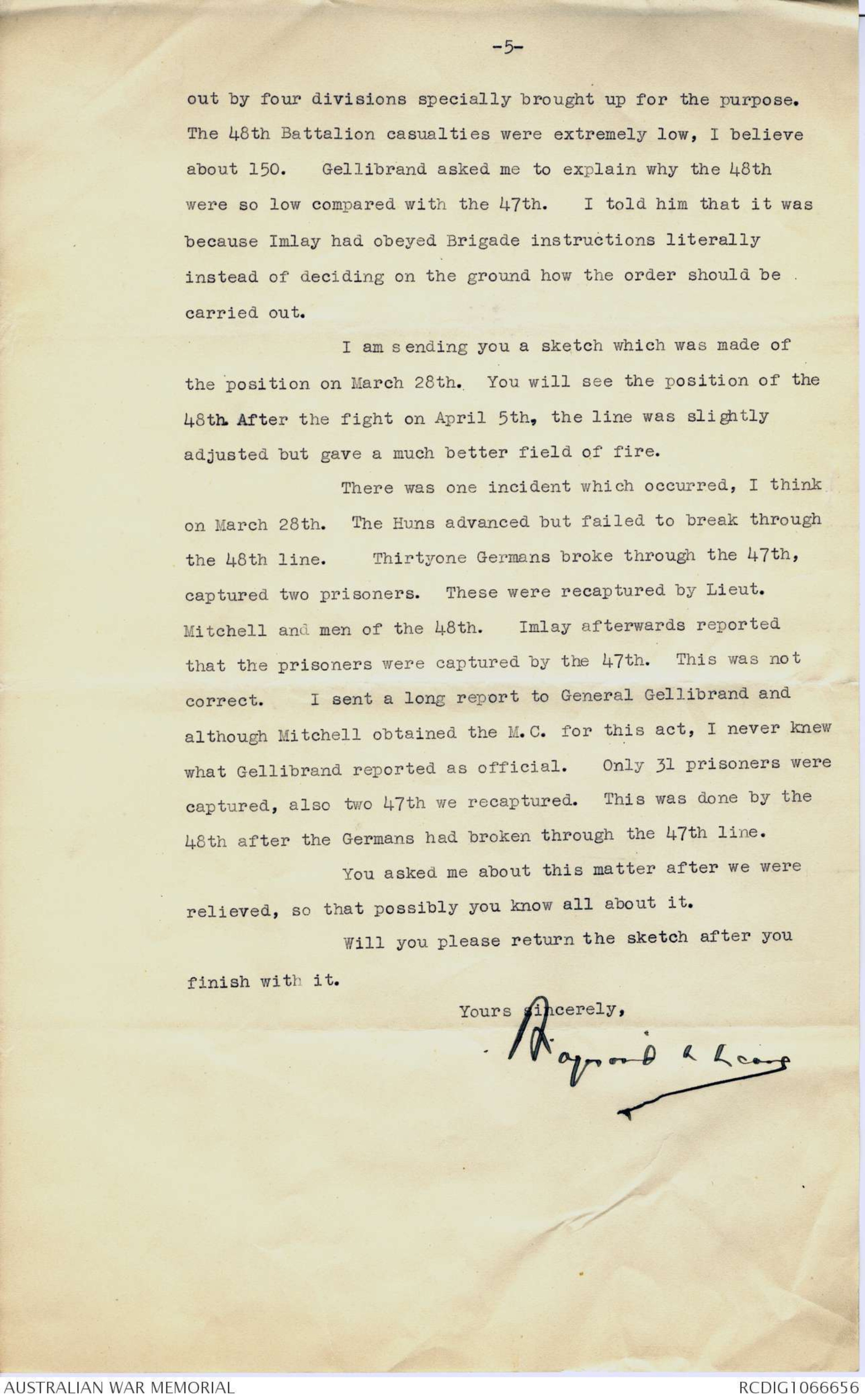
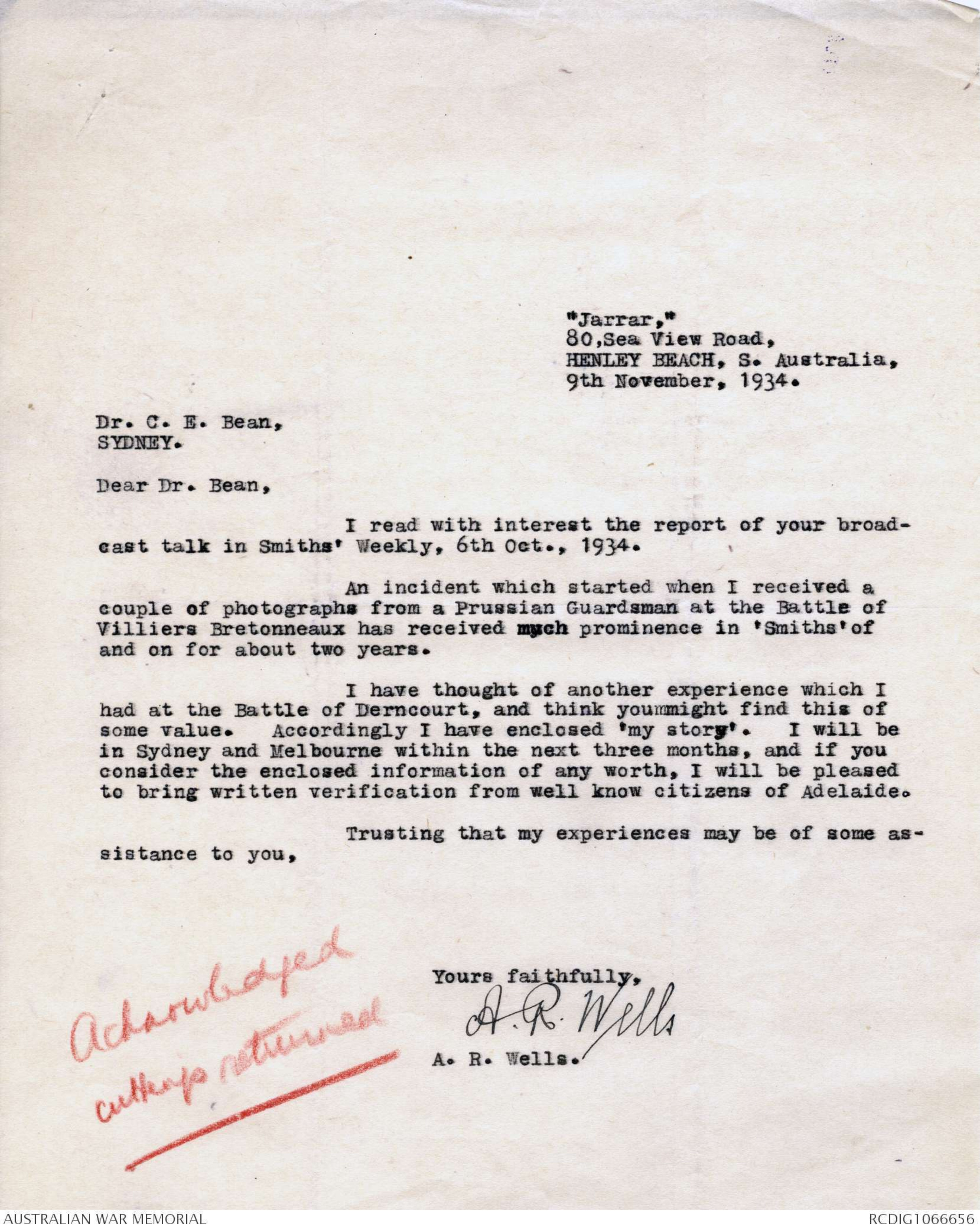
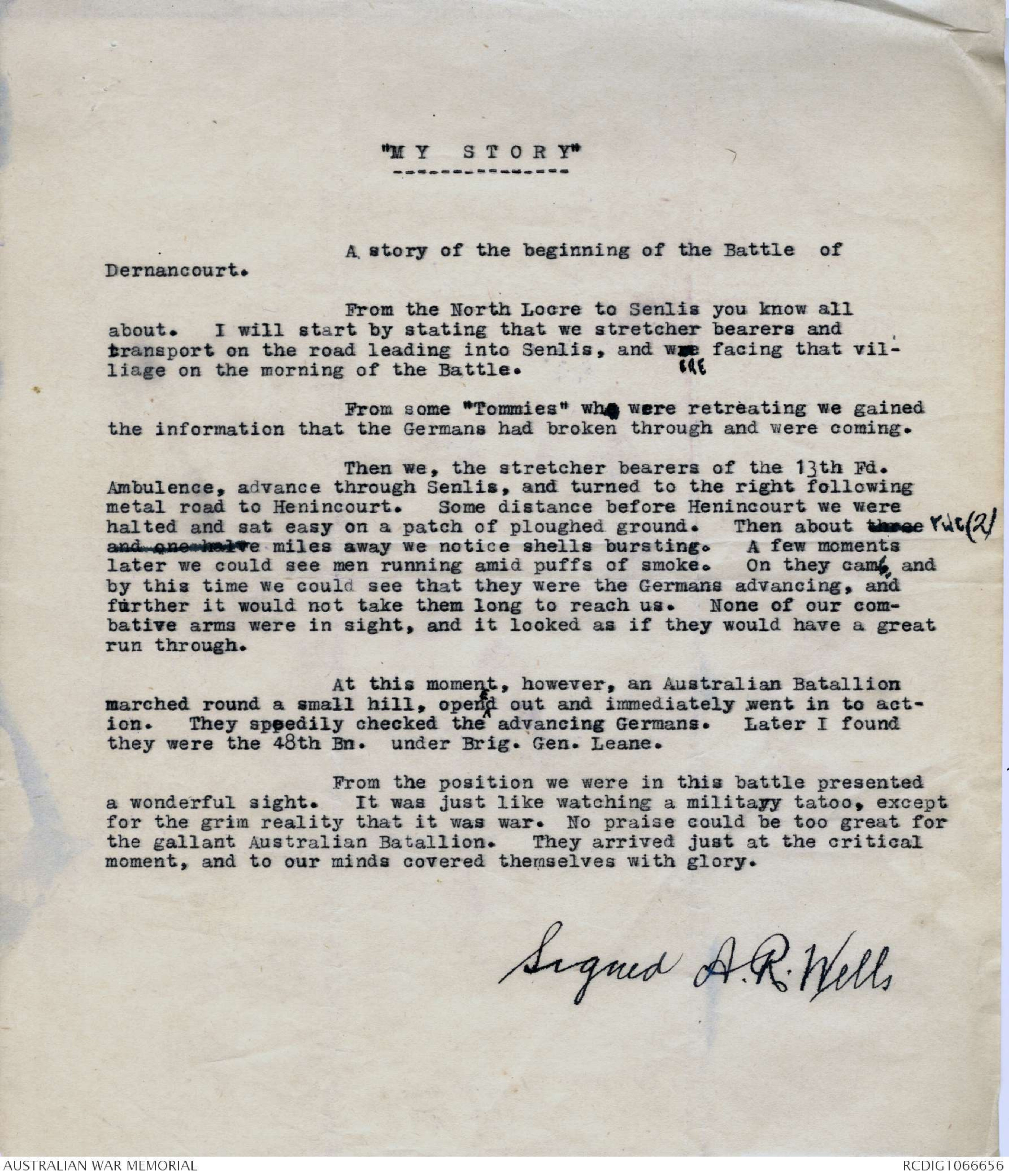
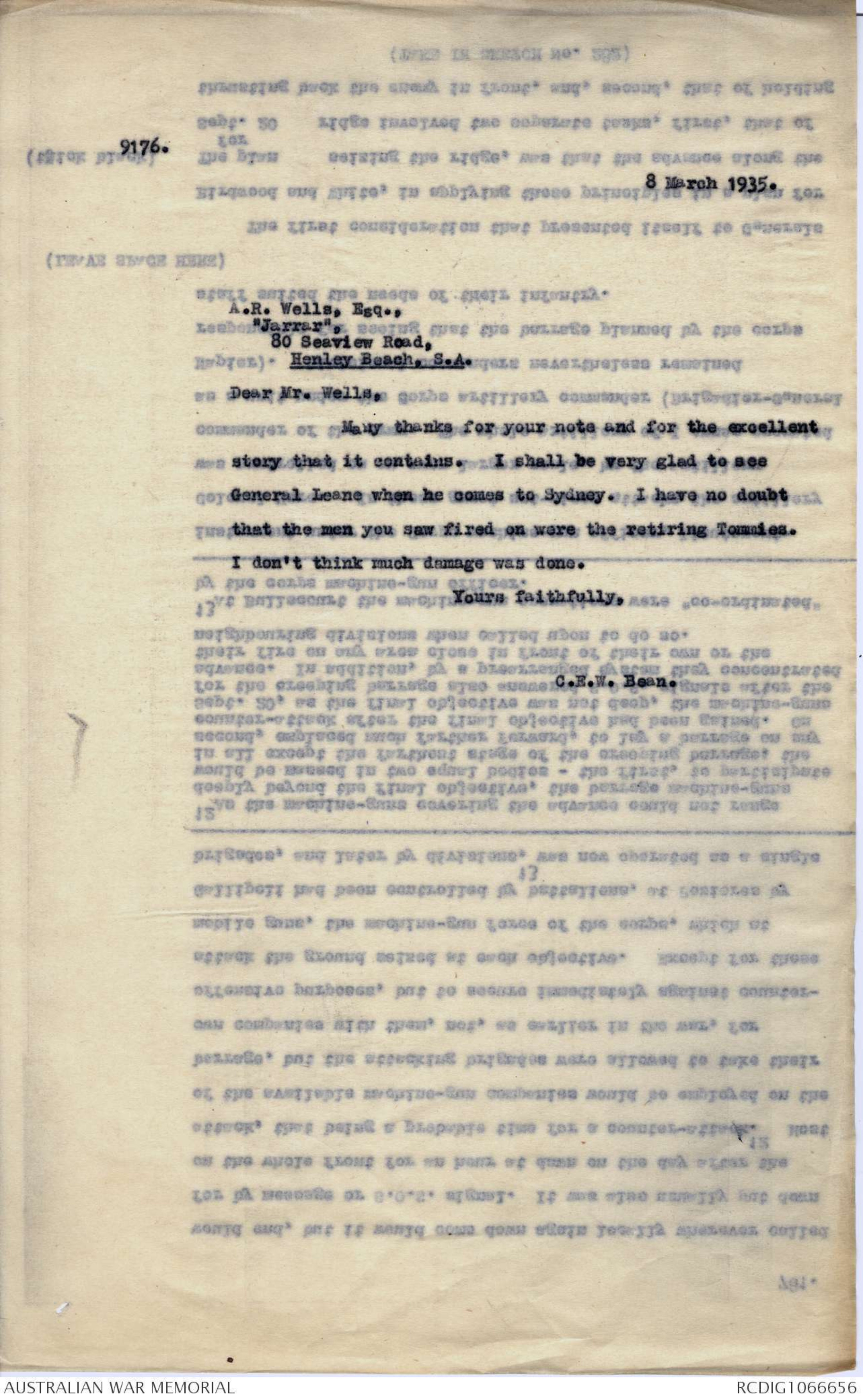
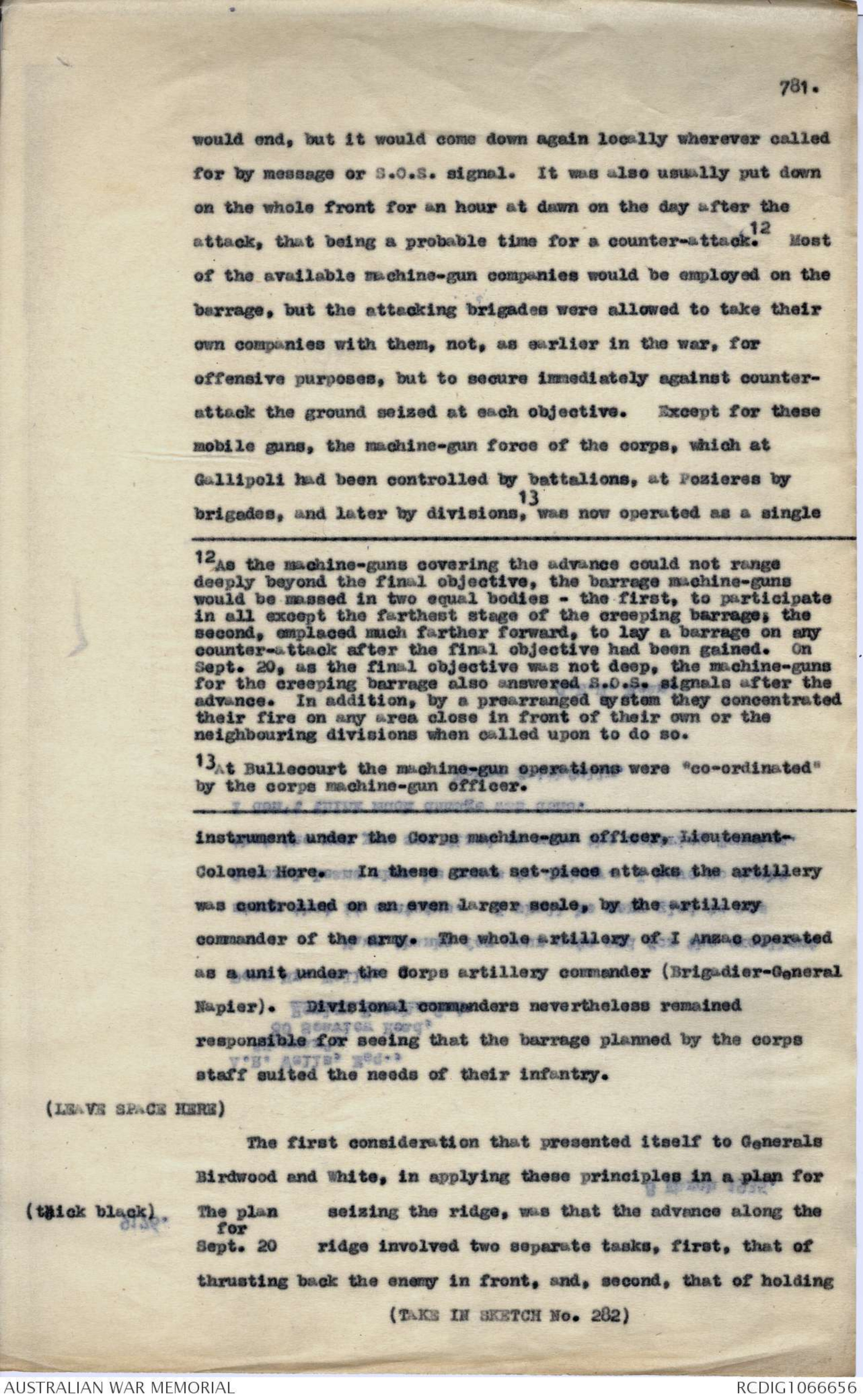
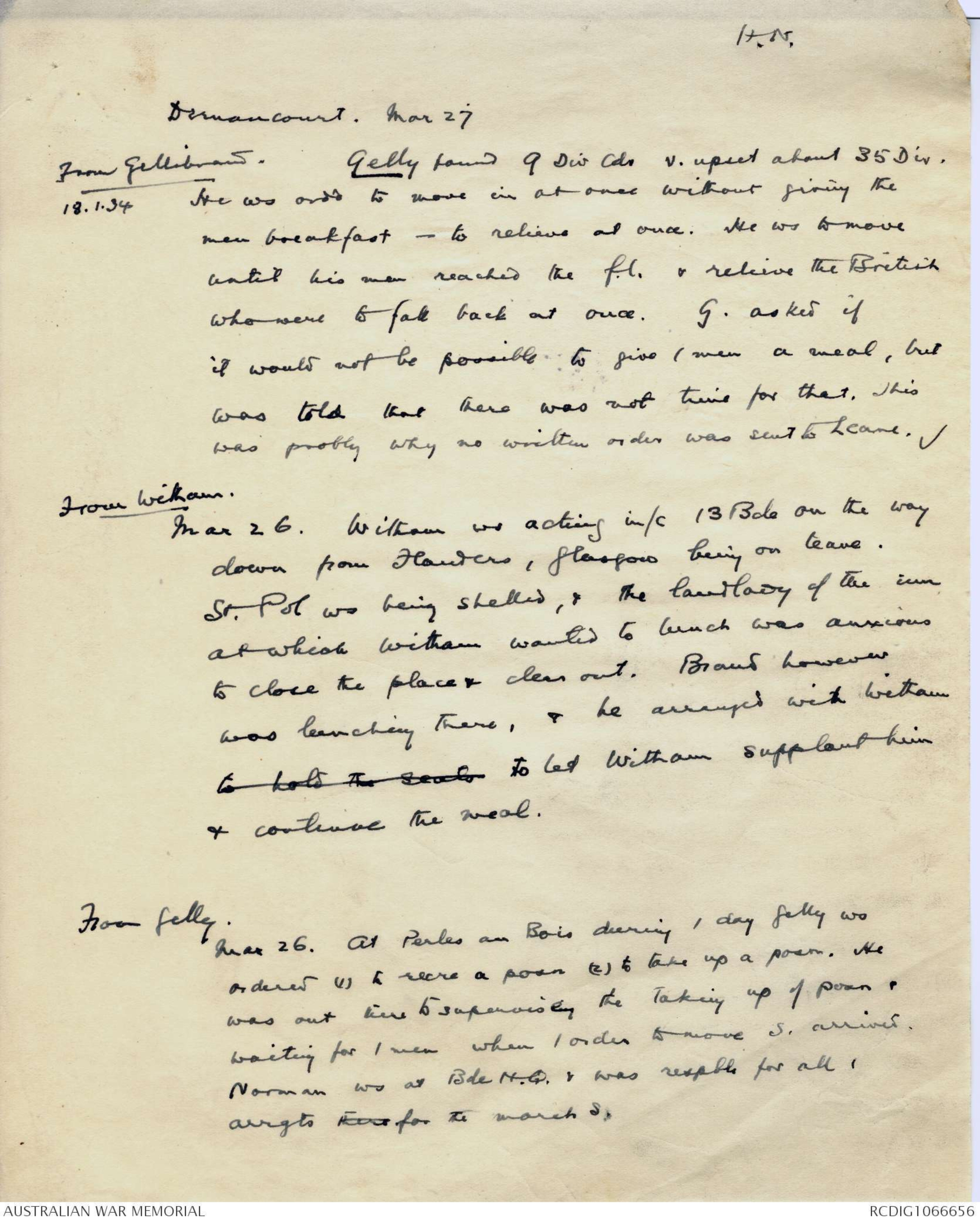
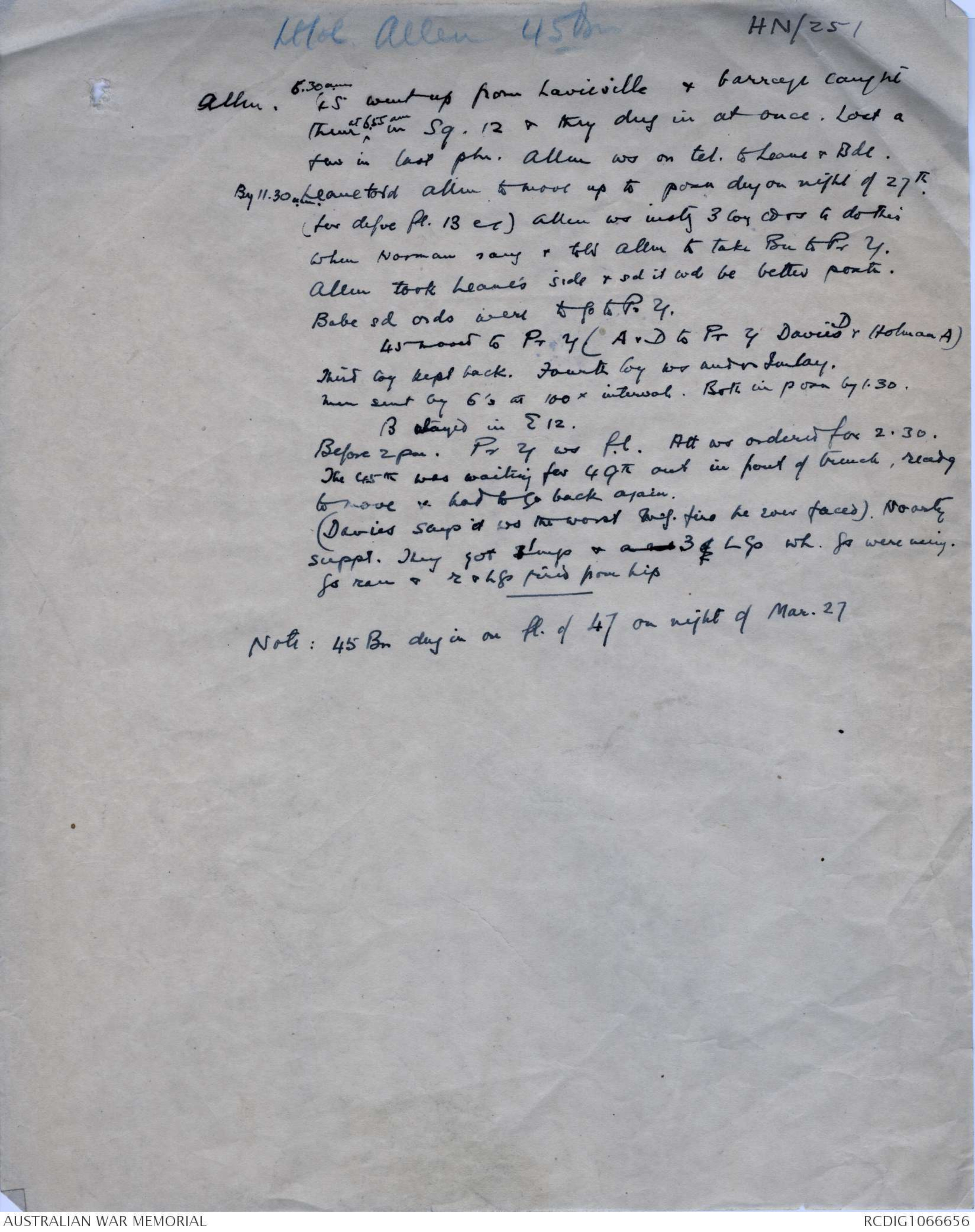
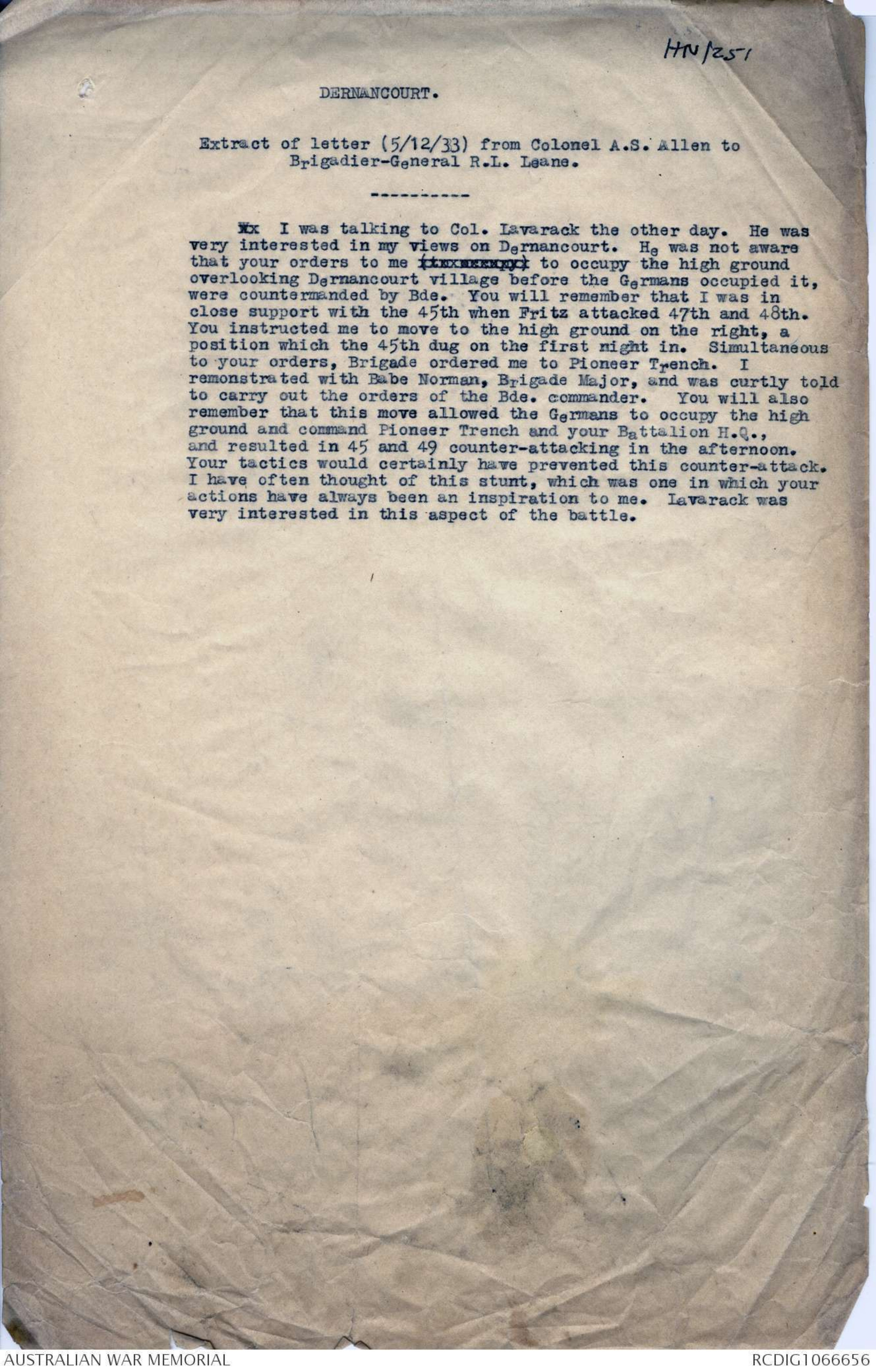
-3-
message. Gellibrand would be the first to condemn me
for accepting an order under such circumstances. I went to
look for Brigade and found the Brigadier shortly afterwards.
He confirmed the order, instructing me to occupy the railway
embankment and prevent the Germans advancing along the
Albert Amiens Road. He stated that he believed that this
position was held by British Troops which the 12th Brigade
would relieve. I saw the 47th moving between Henencourt
and Lavieville. Immediately upon return the 48th, which I
had given instructions to be ready to move, moved towards
Albert. Time wod be about 12.30 p.m. The move forward
was in artillery formation on a frontage of about 600 yards and
a depth of 2000 yards. The ground was very open and I knew
that our advance would be clearly seen by the Germans from
the high ground behind Albert. I decided that it was quite
useless attempting to relieve the English or reach the
Embankment before dark because of the heavy casualties we
would suffer, so I decided to occupy the trenches built on
the forward slope which had a fine field of fire and covered
the advance towards Amiens. The Enemy shelled us heavily
during the advance, but I reached the position without any
casualties from enemy fire although I lost one man, killed,
and four wounded, fired on by an English Plane. I understand
the observer had been instructed that all troops east
of Henencourt were Germans. About 2.30 p.m. I decided to
reconnoitre the front and taking Downes, who was Assistant
Adjutant and two runners, I moved across to the high ground
overlooking Dernancourt. Here I found members of the 47th
also English Soldiers. They were suffering casualties from
shell fire directed from behind Dernancourt. I was given to
understand that the reason for the severe shelling had been
caused by the advance of the 47th. I learned that the
Battalion had lost heavily in the advance, particularly when
trying to push down the forward slopes where they came under
machine gun fire. However, Imlay had obeyed the command he
-4-
received from Gellibrand. There was no need for the hurry.
English were in position and could not leave it before
dark without severe loss. Therefore, the solution was to
wait for darkness to cover the movement down the forward
slopes to the Railway Embankment. I never believed in
reckless waste of men when the object could be achieved
without it.
Informing the 47th of the location of the 48th
I moved along the high ground towards the Albert Road. I
saw quite a number of the 47th, but could not ascertain where
Imlay had established Headquarters, nor did I see the post
supposed to have been established. Men of the 47th were
in trenches which I later occupied with supports. I found
English troops on the Albert Road and later occupied the
position. It was here that I was picked up by the Enemy
Artillery which followed me all the way back to my own
Headquarters. Downes was wounded. Having decided to remain
in the present position until dark, I sent a sketch and a
report to Brigade. Between then, at about 4.20 p.m. and dark,
I received several messages directing me to push forward.
About 5 p.m. I located Imlay who had his Headquarters about
400 yards south of the 48th. Orders given by a senior must
be obeyed, but if he was not present and able to ascertain
the conditions I always believed ^in deciding for myself how I
would carry the order out, having due regard to the prevention
of casualties, a matter which appeared so often to have
no weight with the higher Command. I never gave a definite
command to a subordinate unless I was able by personal
reconnaissance to know that it could be done with minimum
casualties.
During the whole of this operation from
March 27th to April 6th, during which period at least two
efforts were made by the Huns to break through, and the
48th stood the brunt of the big attack on April 5th,
prisoners captured informed me that the attack was carried
-5-
out by four divisions specially brought up for the purpose.
The 48th Battalion casualties were extremely low, I believe
about 150. Gellibrand asked me to explain why the 48th
were so low compared with the 47th. I told him that it was
because Imlay had obeyed Brigade instructions literally
instead of deciding on the ground how the order should be
carried out.
I am sending you a sketch which was made of
the position on March 28th. You will see the position of the
48th. After the fight on April 5th, the line was slightly
adjusted but gave a much better field of fire.
There was one incident which occurred, I think
on March 28th. The Huns advanced but failed to break through
the 48th line. Thirtyone Germans broke through the 47th,
captured two prisoners. These were recaptured by Lieut.
Mitchell and men of the 48th. Imlay afterwards reported
that the prisoners were captured by the 47th. This was not
correct. I sent a long report to General Gellibrand and
although Mitchell obtained the M.C. for this act, I never knew
what Gellibrand reported as official. Only 31 prisoners were
captured, also two 47th we recaptured. This was done by the
48th after the Germans had broken through the 47th line.
You asked me about this matter after we were
relieved, so that possibly you know all about it.
Will you please return the sketch after you
finish with it.
Yours sincerely,
Raymond L Leane
"Jarrar,"
80, Sea View Road,
HENLEY BEACH, S. Australia,
9th November, 1934.
Dr. C. E. Bean,
SYDNEY.
Dear Dr. Bean,
I read with interest the report of your broadcast
talk in Smiths' Weekly, 6th Oct., 1934.
An incident which started when I received a
couple of photographs from a Prussian Guardsman at the Battle of
Villiers Bretonneaux has received much prominence in 'Smiths' of
and on for about two years.
I have thought of another experience which I
had at the Battle of Derncourt, and think yoummight find this of
some value. Accordingly I have enclosed 'my story'. I will be
in Sydney and Melbourne within the next three months, and if you
consider the enclosed information of any worth, I will be pleased
to bring written verification from well know citizens of Adelaide.
Trusting that my experiences may be of some assistance
to you,
Yours faithfully,
A. R. Wells
A. R. Wells.
Acknowledged
cuttings returned
"M Y S T O R Y"
--------------------
A story of the beginning of the Battle of
Dernancourt.
From the North Locre to Senlis you know all
about. I will start by stating that we stretcher bearers and
transport on the road leading into Senlis, and wasere facing that villiage
on the morning of the Battle.
From some "Tommies" who were retreating we gained
the information that the Germans had broken through and were coming.
Then we, the stretcher bearers of the 13th Fd.
Ambulence, advance through Senlis, and turned to the right following
metal road to Henincourt. Some distance before Henincourt we were
halted and sat easy on a patch of ploughed ground. Then about three two (2)and one halve miles away we notice shells bursting. A few moments
later we could see men running amid puffs of smoke. On they came, and
by this time we could see that they were the Germans advancing, and
further it would not take them long to reach us. None of our combative
arms were in sight, and it looked as if they would have a great
run through.
At this moment, however, an Australian Batallion
marched round a small hill, open^ed out and immediately went in to action.
They speedily checked the advancing Germans. Later I found
they were the 48th Bn. under Brig. Gen. Leane.
From the position we were in this battle presented
a wonderful sight. It was just like watching a militayy tatoo, except
for the grim reality that it was war. No praise could be too great for
the gallant Australian Batallion. They arrived just at the critical
moment, and to our minds covered themselves with glory.
Signed A.R. Wells
9176.
8 March 1935.
A.R. Wells, Esq.,
"Jarrar",
80 Seaview Road
Henley Beach, S.A.
Dear Mr. Wells,
Many thanks for your note and for the excellent
story that it contains. I shall be very glad to see
General Leane when he comes to Sydney. I have no doubt
that the men you saw fired on were the retiring Tommies.
I don't think much damage was done.
Yours Faithfully,
C.E.W. Bean.
781.
would end, but it would come down again locally wherever called
for by message or S.O.S. signal. It was also usually put down
on the whole front for an hour at dawn on the day after the
attack, that being a probable time for a counter-attack.12 Most
of the available machine-gun companies would be employed on the
barrage, but the attacking brigades were allowed to take their
own companies with them, not, as earlier in the war, for
offensive purposes, but to secure immediately against counter-
attack the ground seized at each objective. Except for these
mobile guns, the machine-gun force of the corps, which at
Gallipoli had been controlled by battalions, at Pozieres by
brigades, and later by divisions,13 was now operated as a single
-----------------------------------------------
12 As the machine-guns covering the advance could not range
deeply beyond the final objective, the barrage machine-guns
would be massed in two equal bodies - the first, to participate
in all except the farthest stage of the creeping barrage; the
second, emplaced much farther forward, to lay a barrage on any
counter-attack after the final objective had been gained. On
Sept. 20, as the final objective was not deep, the machine-guns
for the creeping barrage also answered S.O.S. signals after the
advance. In addition, by a prearranged system they concentrated
their fire on any area close in front of their own or the
neighbouring divisions when called upon to do so.
13 At Bullecourt the machine-gun operations were "co-ordinated"
by the corps machine-gun officer.
--------------------------------------------------
instrument under the Corps machine-gun officer, Lieutenant-
Colonel Hore. In these great set-piece attacks the artillery
was controlled on an even larger scale, by the artillery
commander of the army.: The whole artillery of I Anzac operated
as a unit under the Corps artillery commander (Brigadier-General
Napier). Divisional commanders nevertheless remained
responsible for seeing that the barrage planned by the corps
staff suited the needs of their infantry.
(LEAVE SPACE HERE)
The first consideration that presented itself to Generals
Birdwood and White, in applying these principles in a plan for
[*(thick black) The plan
for
Sept. 20 *]
seizing the ridge, was that the advance along the
ridge involved two separate tasks, first, that of
thrusting back the enemy in front, and, second, that of holding
(TAKE IN SKETCH NO. 282)
H.N.
Dernancourt. Mar 27
[*From Gellibrand.
18.1.34*]
Gelly found 9 Div Cdr v. upset about 35 Div.
He ws ordd to move in at once without giving the
men breakfast - to relieve at once. He ws to move
until his men reached the f.l. & releive the British
who were to fall back at once. G. asked if
it would not be possible to give / men a meal, but
was told that there was not time for that. This.,
was probly why no written order was sent to Leane. ✓
From Witham.
Mar 26. Witham ws acting in/c 13 Bde on the way
down from Flanders, Glasford being on leave.
St. Pol ws being shelled, & the landlady of the inn
at which Witham wanted to lunch was anxious
to close the place & clear out. Brand However
ws lunching there, & he arranged with Withamto hold the seats to let Witham supplant him
& continue the meal.
From Gelly.
Mar 26. At Perles au Bois during / day Gelly ws
ordered (1) to secure a posn (2) to take up a posn. He
was out there to supervise by taking up of posn &
waiting for / men when / order to move S. arrived.
Norman ws at Bde H.Q. & was respble for all /
arrgts there for the march S.
Lt Col Allen 45th HN/2S1
Allen 6.30 a.m. 45 went up from Lavieville & barrage caught
them at 6.55 a.m. in Sq. 12 & they dug in at once. Lost a
few in last pln. Allen ws on tel. to Leane & Bde.
By 11.30 a.m. Leane told Allen to move up to posn dug on right of 27th
(for defve Pt. 13 [shorthand]) Allen ws instg 3 Coy cdrs to do this
when Norman rang & told Allen to take Bn to Pr trench.
Allen took Leane's side & sd it wd be better postn.
Babe sd ords were to go to Pr trench.
45 moved to Pr trench (A & D to Pr trench Davies - D & Holman A)
Third Coy kept back. Fourth Coy ws under Imlay.
men sent by 6's at 100x intervals. Both in posn by 1.30.
B stayed in E 12.
Before 2 pm. Pr trench ws f.l. Att ws ordered for 2.30.
The 45th was waiting for 49th out in front of trench, ready
to move & had to go back again.
(Davies says it ws the worst m.g. fire he ever faced). No arty
suppt. The got / mgs & a no 3 of LGs wh. Gs were using.
Gs ran & m & LGs fired from hip
———
Note: 45 Bn dug in on fl. of 47 on night of Mar. 27
HN/251
DERNANCOURT.
Extract of letter (5/12/33) from Colonel A.S. Allen to
Brigadier-General R.L. Leane.
-------------xx I was talking to Col. Lavarack the other day. He was
very interested in my views on Dernancourt. He was not aware
that your orders to me xxxxxxxxxx to occupy the high ground
overlooking Dernancourt village before the Germans occupied it,
were countermanded by Bde. You will remember that I was in
close support with the 45th when Fritz attacked 47th and 48th.
You instructed me to move to the high ground on the right, a
position which the 45th dug on the first night in. Simultaneous
to your orders, Brigade ordered me to Pioneer Trench. I
remonstrated with Babe Norman, Brigade Major, and was curtly told
to carry out the orders of the Bde. commander. You will also
remember that this move allowed the Germans to occupy the high
ground and command Pioneer Trench and your Battalion H.Q.,
and resulted in 45 and 49 counter-attacking in the afternoon.
Your tactics would certainly have prevented this counter-attack.
I have often thought of this stunt, which was one in which your
actions have always been an inspiration to me. Lavarack was
very interested in this aspect of the battle.
 Sam scott
Sam scottThis transcription item is now locked to you for editing. To release the lock either Save your changes or Cancel.
This lock will be automatically released after 60 minutes of inactivity.